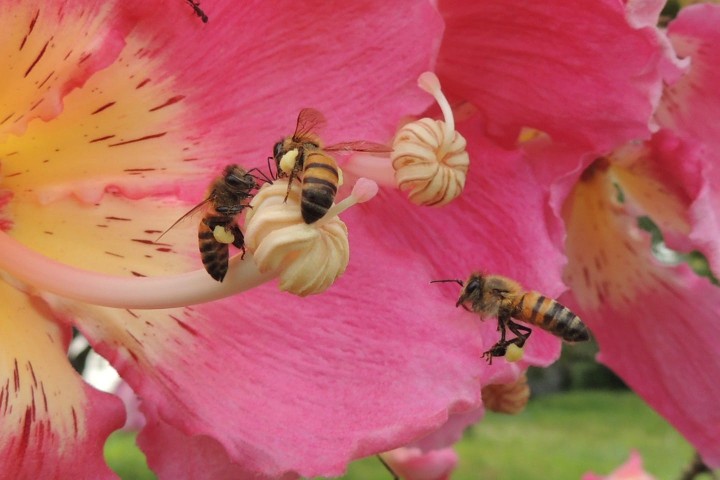More trees means healthier bees, new study on air pollution reveals

Bees pollinating a paineira-rosa flower, Sao Paulo, Brazil. Image: Mauro Halpern, CC BY 2.0.
Human-caused air pollution in Brazil’s São Paulo state is taking its toll on native bees, but the presence of plants can help ameliorate those effects, a new study shows.
Researchers from the University of São Paulo (USP) and São Paulo State University (UNESP) studied jataí bees (Tetragonisca angustula) as bioindicators of environmental quality — proverbial canaries in the coal mine — to confirm a direct relationship between the amount of vegetation and air pollution.
Plants act as a filter and a protective barrier, and the larger the green area in a given region, the lower the levels of pollutants in the environment and, consequently, in the bees, the study found.
The findings have important implications, given that bees are the main pollinators in the animal kingdom, responsible for pollinating 75 per cent of all farmed plants worldwide.
The study measured accumulated levels of 21 chemical elements in the tissues of jataí bees collected in eight areas in São Paulo state where remnants of the Atlantic Forest still stand. These areas had forest cover ranging from 16-70 per cent, and varying types and levels of human activity and presence, such as agriculture, roads, cities, industries, pastures and degraded land.
“The distinguishing feature of our work is that our bioindicators were a group of bees that had not been studied on a global scale and are widely distributed in Brazil, occurring both in urban areas and in preserved areas,” said the author of the study Marcela de Matos Barbosa, an entomologist at USP.
Barbosa said that when the bees fly through different environments to collect pollen, they can carry fine particles of atmospheric aerosols from the surrounding pollution.
The study shows that bees living in more forested areas have lower levels of mercury, copper, cadmium and chromium in their bodies. The main source for heavy metals such as cadmium and chromium are the agrochemicals used on farms.
It also shows how different types of land use influence the presence of the pollutants found in the bees. For example, where there are roads, the bees accumulate chromium, mercury, aluminum, uranium, arsenic, lead and platinum in their bodies. In areas with degraded soil or pastures, the main pollutants found are zinc, cadmium, manganese, magnesium, barium and strontium.
The importance of urban ecological corridors
The findings add to a growing body of evidence about the importance of mitigation projects such as afforestation in urban areas, said study coordinator Milton Cezar Ribeiro, a professor at UNESP’s Biosciences Institute.
According to Ribeiro, urban ecology is a field that has been growing recently in academia. It addresses the creation of urban ecological corridors from an ecological and socio-environmental perspective.
“We created a tool to simulate the best scenarios within a human and non-human context, where certain groups of plants are selected according to the routes to connect the city center to the outskirts,” he said.
Ribeiro said that taking care of landscapes separately without connecting them isn’t enough. “Planting trees in the streets is vital, as well as encouraging the use of vegetation in houses, buildings and even on walls.”
Giuliano Locosselli, a biologist at the USP Biosciences Institute and author of a pioneering study published in 2019 that showed how pollution in the city of São Paulo impacts tree growth, said it is also important to select the right plant species to create urban ecological corridors.
“Some trees are more resistant to pollution while others are less resistant. The question today is to know which ones are what,” Locosselli said. “We are trying to answer this question under a larger project that is part of a major international consortium focused on nature-based solutions. The idea is to help municipalities and decision-makers to build more efficient and resilient urban forests.”
Lack of effective policies
Public policies and law enforcement, however, have been major obstacles to progress on this front. In the city of São Paulo, for example, a law proposed in 2009 mandated that the entire public bus fleet running on diesel switch to clean fuels by 2018. But this has not been enforced to date, and diesel emissions are now responsible for almost 95 per cent of particulate matter — the most toxic pollutant to human health.
Cases like this are among the reasons why air pollution is today the world’s top cause of illness and death from chronic non-communicable diseases, responsible for 40 per cent of deaths from heart attacks and 50 per cent of cases of pneumonia in children. Air pollution is also considered the top reason for infant mortality, in addition to being responsible for 6 per cent of cases of lung cancer.
Evangelina Vormittag, former technical director of the microbiology laboratory at USP’s medical school and founder and director of Instituto Saúde e Sustentabilidade (Institute of Health and Sustainability), said that these figures are a tragedy playing out in real time, with the government lacking the political will to make a meaningful change.
“Brazil needs governments with the strength and courage to make the necessary change, and that requires confronting economic forces,” she said. “For example, there is a 20-plus-year-old law that mandates vehicle inspection throughout Brazil, and states must comply with it, but no state does. What is the sanction? Nothing.”
Vormittag’s institute, together with more than 20 other organisations under the Coalizão Respirar (Breathe Coalition), filed a lawsuit challenging the constitutionality of the criteria adopted by Brazil’s National Council for the Environment (CONAMA) for establishing air quality standards.
“Since 2005, the World Health Organisation (WHO) has determined concentration levels of pollutants that are safe for health. We are now in 2021 and the levels we take as legal are three times higher than what the WHO recommends,” Vormittag said. “In practice, what happens is that states, which are responsible for managing air quality, are allowed to pollute three times more. The air is polluted and they say it’s normal. And nobody warns the population about it.”
She points out that none of the nine states that make up the Brazilian Amazon monitors their air quality. Their failure to do so is something that Vormittag describes as catastrophic.
“In the Amazon there is neither measurement nor assessment. So if there was any monitoring, it would be a scandal,” she said. “The levels of pollution by particulate matter in areas with fires are similar to China’s.”
This story was published with permission from Mongabay.com.

